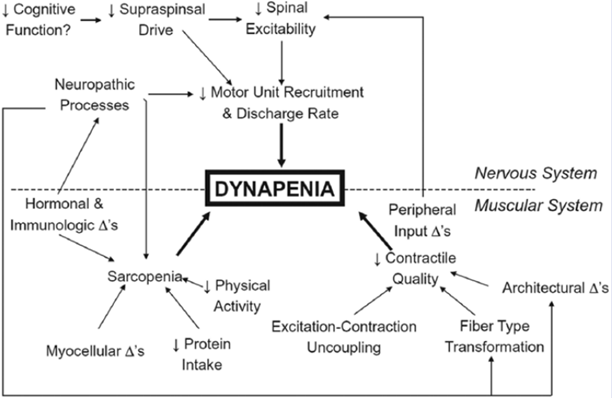Rev Bras Fisiol Exerc 2022;21(2):90-1
doi: 10.33233/rbfex.v21i2-5218
EDITORIAL
Is there a causal relationship between sarcopenia and dynapenia in patients undergoing bariatric surgery?
Luji Iseki Takenami, Felipe Nunes Almeida Santos, Clarcson
Plácido Conceição dos Santos
Escola
Bahiana de Medicina e Saúde Pública, Salvador, BA, Brazil
Luji Iseki Takenami: lujitakenami20.1@bahiana.edu.br
Felipe
Nunes Almeida Santos: felipesantos
17.1@bahiana.edu.br
Clarcson Plácido C. dos Santos:
clarcson@hotmail.com
Sarcopenia is defined, in the Greek
language, as “poverty of the flesh” and, at first, it was treated as the
natural process of aging related to the decline of the lean mass [1]. This
concept, however, is still not established. Some authors limit sarcopenia only
to the loss of lean mass, others also associate it with loss of muscle strength
- called dynapenia - unifying the two concepts [2]. Furthermore,
sarcopenia is not only linked to the aging process, as it involves a
multifactorial system such as obesity, for example.
Obesity is a global epidemic
condition of significant social and economic impact that can lead to chronic
diseases, functional limitations, high risk of mortality, and, when associated
with the diagnosis of sarcopenia, is called sarcopenic obesity [3]. Obese
patients have a greater amount of muscle mass and strength compared to
non-obese individuals and morphological changes such as weight loss generally
have repercussions on the decrease in lean mass, causing sarcopenia (SO) [3].
The European Working Group on
Sarcopenia in Older People (EWGSOP) is responsible for the currently most used
guideline for the diagnosis and grading of sarcopenia [1]. The muscular
strength with the handgrip test, the volume of lean mass with the study of
bioimpedance, and the gait speed in the walking test, also applied in the Short
Physical Performance Battery (SPPB), are the evaluated parameters, being
possible to grade the sarcopenia in pre -sarcopenia, sarcopenia and severe
sarcopenia [1,2]. The guideline EWGSOP2, an updated version of EWGSOP, uses the
sit-to-stand test (SST) as a muscle strength parameter, evaluating the speed of
the individual in getting up from a chair [3].
In a recent study, women undergoing
bariatric surgery in a period of weight stability, when compared with women
with SO who did not undergo the same surgery, performed better on the SST and
SPPB [3]. In another study, it was estimated that the prevalence of SO in the
elderly (≥ 60 years) in the world was 15% when the diagnosis of
sarcopenia was based only on the volume of lean mass and decreased to 4% when
muscle strength and physical functionality were considered [4]. These results
refer to the possibility of the current guidelines are neglecting the influence
of body fat index, in addition to raising the hypothesis that there is no
causal relationship between sarcopenia and dynapenia.
The Figure 1 presents a working
model for one of the current perceptions about the etiological multifactorial
system of dynapenia in the elderly. The hypothesis to
be tested is the inexistence of a causal relationship between sarcopenia and dynapenia and to investigate other factors capable of
influencing more significantly, such as body fat index, the outcome of dynapenia in obese individuals.
The understanding of the
multifactorial system that involves the development of sarcopenia and dynapenia, the elucidation of their concepts, and the
understanding of the nature of the causal relationship between the two
conditions can work in the prevention of motor dysfunction in obese and elderly
individuals and improve the quality of life for this population.

Figure 1 – Working model created by
Clark & Manini [5] to explore the multifactorial biological mechanisms that
may influence the loss of muscle strength in the elderly
References
- Delmonico MJ, Beck DT. The current
understanding of sarcopenia: Emerging tools and interventional possibilities.
American Journal of Lifestyle Medicine 2017;11:167-81. doi: 10.1177/1559827615594343 [Crossref]
- Silva TA, Duarte YAO, Santos FJL, Wong R, Lebrão ML. Sarcopenia according to the European working group on sarcopenia in older people (EWGSOP) versus Dynapenia as a risk factor for disability in the elderly. J Nutr Health Aging 2014;18(5):547-53. doi: 10.1007/s12603-014-0465-9 [Crossref]
- Buzza AFB, Machado CA, Pontes F, Sampaio LG, Contador JS, Sampaio CL, et al. Prevalence of sarcopenia in women at stable weight phase after Roux-en-Y gastric bypass. Arch Endocrinol Metabol 2022. doi: 10.20945/2359-3997000000494 [Crossref]
- Gao Q, Mei F, Shang Y, Hu K, Chen F, Zhao L, et al. Global prevalence of sarcopenic obesity in older adults: A systematic review and meta-analysis. Clin Nutr 2021;40(7):4633-41. doi: 10.1016/j.clnu.2021.06.009 [Crossref]
- Clark BC, Manini TM. Functional consequences of sarcopenia and dynapenia in the elderly. Curr Opin Clin Nutr Metab Care 2010;13(3):271-6. doi: 10.1097/MCO.0b013e328337819e [Crossref]
